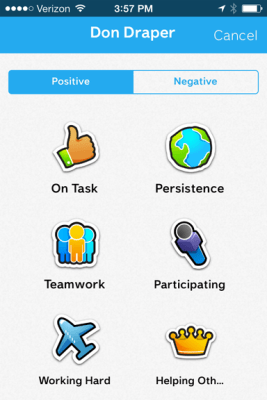ClassDojo, software for tracking classroom behavior and incentivizing students, has updated its mobile app to allow teachers to access all the desktop features from a mobile device. Now teachers can use ClassDojo on the playground, on field trips and in classrooms with poor Wi-Fi. This addition will also expand the company’s user base to low-funded schools that don’t have computers for every classroom.
Launched in 2011, ClassDojo helps teachers monitor student behavior through a free online platform. Each student has an avatar that receives or loses points throughout the day based on behavior, which teachers can then share with parents. ClassDojo motivates students through a public leader board, which shows each avatar’s progress throughout the day. Co-founder Sam Chaudhary says the platform is designed to help kids develop vital skills such as creativity, hard work and collaboration, instead of focusing on just academics.
With the new mobile app, users can set up classes, take attendance, view progress reports and invite other teachers. Previously, the app could give and take points from students but was made to be more of a remote control to the website. The ability to use ClassDojo’s software from a smartphone is an advantage over other behavior management systems, such as IRIS and EPraise.
But Chaudhary tells me he considers traditional behavior charts his main competition, since many teachers have already developed their own methods of managing students. ClassDojo just launched a teacher collaboration tool last week and is slowly rolling it out to all users. This means ClassDojo can provide a standard platform for educators across classrooms. Chaudhary says another advantage to is the ability to monitor data.
“With all the names on the board, these things get thrown away at the end of the year. And none of that actually leads to long-term improvement, because it refreshes every year,” he tells me.
The platform is free, which lowers the barrier to entry even further. ClassDojo will stay free of charge to all teachers, but the company is looking to monetize through parents. People who want to use ClassDojo with kids at home will be able to pay per month for the service.
As mentioned in a previous TechCrunch article as well as several blogs, ClassDojo is not for everyone. Some teachers opt for deeper communication with students rather than relying on behavior charts and extrinsic rewards. This approach takes more time, but could be more effective than a simple points system in the long run.
Chaudhary doesn’t see ClassDojo as an extrinsic motivator, because the program doesn’t trade points for rewards. “We don’t bribe kids in any other way,” he says. “For us, ClassDojo is based entirely on real-time feedback … and how those actually change and improve behavior, instead of setting up a financial transaction.”
